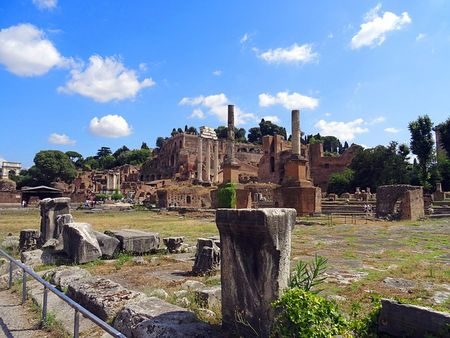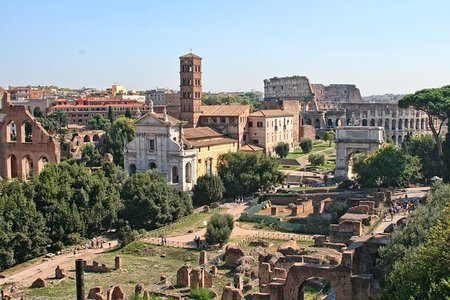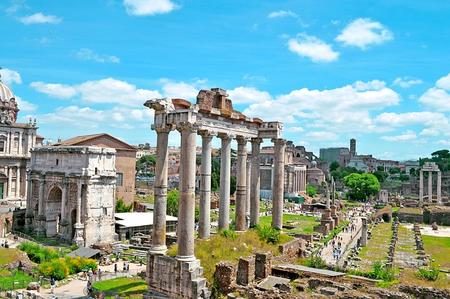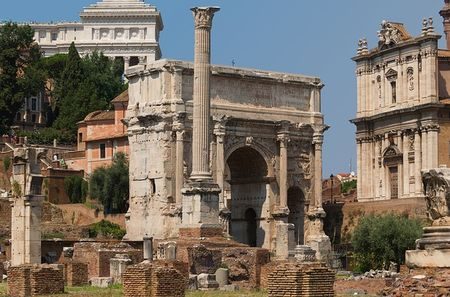Ancient Rome had its own religious, political and social centre where people, artists and leaders converged to make monumental decisions from around 500 BC. About 2000 years ago the kings, councillors and elite Romans (who resided mostly on the Palatine Hill) converged on the Roman Forum (just underneath the hill) to make important decisions.
It’s no surprise that they built their grandest temples and religious altars on another hill at the other end of the Forum…the Capitoline Hill. The Roman Forum is now a series of magnificent ruins between two of the most important hills of Rome; Palatine Hills and Capitoline Hills….the historical centre and erstwhile power nexus of Roma.
Once upon a time, the city’s most important temples, official buildings and power centres stood here. Along with its partners the Colosseum and the Palatine Hill, the Roman Forum (simply referred to as Forum by citizens) is one of the most visited archaeological sites and historical attractions of the world. The Forum stretches over 250m x 170m and has millions of stories buried under its ruins. Archaeologists are still working on unboxing some and those which are discovered are enough to make you fall in love with Roman history forever.

History
Lore says that ancient Rome was founded by brothers Romulus and Remus who were nurtured by a she wolf Lupus on a cave in the Palatine Hill. To know more about the Palatine hills and the lupus archaeological site click here. The brothers grew up and had major conflicts following which Romulus killed Remus and then named the city of Rome after himself. Romulus then began a strategic alliance with his arch rival Titus Tatius and then the Roman Forum was used as a political meeting ground. In those days the Forum was just a marketplace used for dally commercial transactions.
As Rome matured, the forum grew more versatile and public affairs started being held here. As the Forum matured, developed and progressed there were buildings, statues, basilicas and arches that were constructed here. Such was the popularity of this place that by the time Julius Caesar arrived, a new forum space was needed and he and succeeding Emperor Augustus constructed a new zone besides the original forum. By this time all important events in Rome like elections, public speeches, criminal hearings, gladiator marches, business dealings, social gatherings, trading of items, educational events and religious ceremonies came to be held there.
During its long reign, the Forum was reconstructed many times and this is how architecture from separate eras merged together. Influences from every period can be observed in the construction and the design of the buildings and many types of architecture merged together. As a whole the Romans were inspired from classical Greek designs though they created their own structures like domes, amphitheatres, arches, baths and basilicas and all of these used copious quantities of fine marble.

Many important artists were inspired from the Roman forum…even its ruins served as a source of inspiration. Giambattista Piranesi was an Italian artist who lived during the 1700’s …he immortalised the forum by creating a series of sketches that beautifully showed the views of Rome. Literature also shows many references of the Forum; William Shakespeare’s work has multiple mentions of it.
As mentioned earlier, post the advent of Julius Caesar important events began taking place in other elaborate spaces to the north of the Forum. The last major expansion of Forum; Maxentius Basilica happened in 312 AD when Emperor Constantine ruled. The Roman Empire began to fall around 410 AD and most of the old buildings and sites in the Roman Forum began to crumble as well. During the middle ages the Roman Forum was just a pasture for grazing animals; this area began to be known as Campo Vaccino or cattle field.
In 1803 renowned archaeologist Carlo Fea rediscovered the forum and lots of excavations happened in this area over 100 years. The Romans had built over earlier ruins so differentiating the remains from many centuries was a tough job. In 2009 a group of historians and archaeologists discovered remains of pottery and food scraps that dated back to 8th century i.e. at least 100 years before the founding of Rome.
The remains of a historic sewer (Cloaca Maxima) was also discovered and its purpose was ordained to be drainage of the marshy land that once existed between the Capitoline and Palatine Hills up to the River Tiber. When the land dried out, the Etruscan inhabitants began gathering and conducting events in it. When the Romans arrived the place retained its importance and latter this was where the Senate gathered….this in brief is the newest historical story of the Forum. Incidentally excavation work in Rome had yielded the remains of two other Forums; Imperial Fora and Forum Boarium (the Royal Victory Forum and the Cattle Forum).
What To See & Do
The first thing you should look out for in the Roman Forum is the Via Sacra… the most important historic road in the Forum. It was along this road that Emperors journeyed for their coronation and armies marched back to Roma.
Once you reach the Via Sacra, you can take some steps that lead up to the Antoninus Pius Temple that was an ode to Antonius and his wife Faus. This AD 141 dated temple has 6 columns with Corinthian capitals in the front and many embellished columns on the side. This temple was reconstructed (like many other ‘Pagan’ Rome temples) into the church San Lorenzo in Miranda.
Another important site in the Roman Forum is the 12 meter Corinthian columns that survive from the Castor and Pollux temple. The original temple was dated back to 484 BC and was commissioned by the son of infamous dictator Aulus Postumius celebrating the vanquishing of the Tarquins. The present structure was rebuilt in the rule of Tiberius in the first century AD. The twin Gods of the temple i.e. Castor and Pollux were supposed to have brought in numerous war victories and it’s said that their mythical horses fed on streams at the Forum. Incidentally the tall statuesque surviving columns of the Castor Pollux temple are known as ‘Three Sisters’.
Temple of Saturn is still highly revered probably because Saturn is god feared and worshipped by many religions. The Romans worshipped Saturn though they originally had Etruscan origins. The temple was razed by fire multiple times and the last destruction bout took place in 4th century AD but everything was again rebuilt. The state treasury used to be housed here and there was a mystic annual Saturnalia celebration each year. The beautiful but battered 8 ionic columns still mark the Saturn temple site.

Adjacent to the temple are the ruins of Milliarium Aureum or the golden milestone which was the origin point of Via Sacra. The distance of various Roman provinces from the temple stone are marked there in golden figures.
The Temple of Rome and Venus was once one of the most important temples (and the biggest too, it measured 145m x 100m) in the city and now it’s just a grand ruin. This temple was dedicated to Roma (the City Goddess and the Goddess of love and beauty…Venus).
The Septimius Severus Arch is one of the most visually impressive parts of the Roman Forum. This was constructed in 203 AD opposite the Santi Martina e Luca church and was an ode to Septimus Severus and his sons Geta and Caracalla who won the Parthian battle. Scenes from this Great War are described in the huge marble reliefs that are mounted on the arch. The Victory Goddesses hold big trophies and a big inscription that glorifies the power of the emperor and his sons.

One of the base columns also commemorates the 10th anniversary of the accession of the throne of the Diocletian king. Some historians say that the remains of the Rostra were held here. The Severus arch was also the spot of the Umbilicus Urbis or the navel/ centre of Rome.
The Arch of Titus stands at the furthest from Capitol and was supposedly erected by Titus’s successor Domitian after the death of the former. There are reliefs on the arch depicting scenes from the triumphant general’s battle procession to Capitol post the vanquishing of Jerusalem by Titus. This victory in the year 70 AD was the last straw in the defeat of Jewish people in Palestine. Titus is shown in his glorious chariot and he is flanked by the Goddess of Victory who holds a wreath of laurels in her hand. The menorah, a table loaded with showbread and trumpets brought in from the temple treasury are also depicted in the relief.
History says that there were three arches in the Roman Forum. The third arch (or rather the first) was created by King Augustus in 29 BC and it has completely disappeared now.
The Roman senate used to meet in the Curia which is incidentally the best preserved building in the Roman Forum. The very first Curia was constructed in the time of the antiquity but there were several rebuilds due to the damage done by fires etc. Disappointingly, the Curia is devoid of ornamentation and has the capacity to seat 300 senators. The bronze doors of antiquity were changed by Borromini who adapted them to serve as the main door of St John Lateran.
The many changes that were sustained over the centuries were robbed off between the years 1931 and 1937. The Curia is used for exhibitions and has a nice marble for with inlay work though. An expert guide might be able to point out the remnants of the friezes. Look out for the Trajan Anaglyphs i.e. 2 travertine slabs that have reliefs depicting the Roman emperor and the citizens of Rome. The platform beside the forum was the Rostra…a platform from where Roman orators addressed the people. Julius Caesar had it remade in marble and it was from this site that Marc Antony addressed the Romans during the famous Julius Caesar funeral speech.
Right outside the Curia is another attraction…the Tomb of Romulus (Rome’s founder) whose final resting place is buried under black marble. To know more about other Romulus sites you need to visit the Colosseum and the Palatine Hills that are incidentally included as a part of the same ticket as Roman Forum.
Opposite the Curia there is another attraction; the Column of Phocas…one of the youngest archaeological exhibits here (it dates back to 608).
If you happen to visit the Roman Forum or any other part of Rome; you will hear about the importance of the “sacred fire” from the locals. Each first day of the New Year all Romans put out the old fires in their homes and hearths and build a new one. And the biggest fire (revered as ‘sacred flame’) was lit in the Temple of Vestal that stood proudly in the Roman Forum. History says that six priestesses were selected as kids from the best Roan families and they grew up to be keepers of the flame.
The sacred temple of Vesta survived till the 16th century but it was then torn down and its marbles used to build churches. What’s visible now is a reconstructed version done in the 1930’s….one of Mussolini’s attempts to reclaim the lost glory of Italy.
Near the temple of the Vesta there are the well preserved ruins of the Vestal Virgins …another construct commissioned by Septimius Severus. The building plan is instantly recognisable from the foundation design. Statues of the head vestals with an account of their virtues is inscribed on the pedestals. A beautiful image of Pallas Athene that was brought by Aeneas from Troy was housed in the House of Vestals.
The Temple of Romulus is nestled between the Antonio Faustina temple and the Maxentius Constantine Basilica. Most historians however believe that the structure isn’t connected to Romulus but it’s a dedication to the reigning Roman Penates. Look out for its distinctive circular shape and the brick made dome. The two porphyry columns still stand…they have a quality of marble that’s now nearly extinct. In ancient times this was as precious as gold. The Romulus temple door is also original bronze and it’s one of the few surviving constructs of the Roman era.
The Santa Maria Antiqua stands at the base of the Palatine Hill in the Roman Forum….this is referred to as one of the earliest surviving monuments of the Christian period. The Santa Maria church remnants contains a beautiful collection of wall paintings that date across a big period of time right from the 6th century to the 8th century. If you are interested in art and history this is an unmissable attraction…the byzantine style wall paintings are extremely well preserved here. Perhaps this was because the Santa Maria Antiqua was abandoned in the 9th century and then buried during an earthquake. The church was restored in 1900
The above two i.e. the Romulus Temple and Santa Maria Antiqua are now accessible as part of S.U.P.E.R sites and can be accessed by anyone holding an S.U.P.E.R ticket. Earlier they could only be accessed as part of guided tours.
Open Hours, Tours & Tickets
If you are buying tickets physically avoid the booking counter at the Colosseum end of the Forum site as it has long serpentine queues. You can buy your tickets at the Palatine Hill entrance as the lines are shorter there. This ticket office is situated half way down the road Via di San Gregorio that runs from the Colosseum following the base of the Palatine hill and it’s about a 5 minute stroll from the Colosseum. Moreover this is where many hop on hop off sightseeing buses and tour buses drop off tourists.
You can do the Roman Forum exploration after exploring the Palatine Hill (this incidentally offers fantastic bird’s eye view of the forum) and you can then descend orienting yourself gradually to the huge space. Booking tickets online is quicker though there is a 2 euro processing fee. You need to arrive half an hour before the printed time of entry on the ticket.
Roma Pass holders can visit the Roman Forum, Colosseum and Palatine Hill as part of one site. Skip the line tickets and special access tickets are also available ….suitable for those who are averse to waiting in queues.
You can find various options for entry and tours of Roman Forum (including combination tours with other attractions) and book online from this Viator site.
There are many operators who offer walking tours with expert guides and a pair of headphones and fast track entrance tickets. This is a good option of covering a historical destination like Roman Forum in peace and at your own pace. Sometimes the audio guide can be very loud and splitting the pair of earphones between 2 people makes sense.
If you want to visit the restricted sites in the Roman Forum then buy the SUPER ticket. Incidentally, SUPER stands for 7 unique places to visit in Rome. For about 16 euros one can visit the Colosseum, Roman Forum, Palatine Hill with their 7 historical sites i.e. Criptoportico Neroniano, Museo Palatino, Aula Isiaca – Loggia Mattei, House of Augustus, House of Livia, Temple of Romulus and Santa Maria Antiqua.
The Roman Forum is a huge area and it has little shade unlike the Palatine Hill so bringing along plenty of water and beverages, comfortable shoes, sunglasses and a stick (for seniors) is recommended. Also there are no food outlets inside the forum…not even a vending machine. Exploring the Roman Forum and the Palatine Hill and Colosseum will take a day at least and to do quality exploration of these historical places you will need minimum 2 days.
The opening and closing times of the Roman Forum depend on the sunset and so there is a lot of monthly variation. The Roman Forum opens at 8.30 a.m. but closes at 4.30 p.m. from January till mid-February. From mid-February to mid-March the monument closes at 5 p.m. From March to August the Forum remains open till 7.15 p.m.
And in September the Forum closes down at 7 p.m… From October to December the Forum closes at 4.30 p.m. However timings change according to weather…better stay updated through the following information portal (link given under Location & Contacts). Also Temple of Romulus and Santa Maria Antiqua are open on Tuesday, Thursday, and Saturday and Sunday afternoon after 2 pm.
The Roman Forum is a very important archeological area and offers a magnificent historical walk. However there is very less shade so if your plan is to have a picnic leave it for the Palatine Hill. Also there are very few toilets on the Roman Forum…there is one right next to the ticket office at the Forum entrance on Via Dei Imperiali (between Roman Senate and Romulus Temple). There are next to no toilets inside so plan accordingly.
Location & Contacts
The biggest entrance for the Roman Forum is along the Via dei Fori Imperiali between Piazza Venezia and Colosseum near the Piazza Venezia side. There is an exit gate that’s close to the Colosseum but keep in mind that there is no entry to the forum through this gate. Both the Capitoline Hills and Palatine Hills are linked to the roman forum by entry and exit gates.
Roman Forum
Via della Salara Vecchia (Between Colosseum and Piazza Venezia)
Booking & Reference Website
For knowing more about the location and transport details of the Forum, refer to the ‘How to Reach’ section of Palatine Hill (which is same as that of Forum).
 A travel addict. Still celebrating the day when he quit his high-profile corporate job to pursue his passion for travel writing.
A travel addict. Still celebrating the day when he quit his high-profile corporate job to pursue his passion for travel writing.